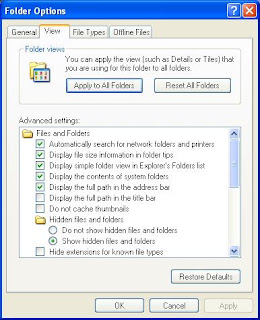Very simply, actually. The collection data is stored in a text file, in JSON format. It's easy to view, too - here's how (instructions for Windows, but easily adapted for users of other platforms):
Plug your Kindle into your PC via its USB cable. Use "My Computer" to navigate to it - it mounts as F: on my desktop box. The collections are stored in the "system" folder, which is normally hidden - to view it, in Windows Explorer choose "Tools" -> "Folder Options...", then select the "View" tab. In the "Advanced Settings" box, select"Hidden files and folders" / "Show hidden files and folders"as shown below:

Click on OK to close the dialog. You should now see the various folders on the Kindle: "audible", "documents", etc. and "system", slightly fainter to indicate it's normally hidden. Open "system" and you'll see various files one shouldn't normally tinker with, including "collections.json". You can open this file with WordPad to see its contents - be warned, it's pretty ugly, but we can do something about that, as you'll see - by right-clicking, choosing "Open" and selecting "Select the program from a list" and then "WordPad" from the resulting dialog (probably best to uncheck "Always use the selected program to open this kind of file" at this stage.
To make sense of what you see, use an online JSON viewer: http://jsonviewer.stack.hu/ You can select all the text in the WordPad window (Ctrl+A), then copy (Ctrl+C) and paste (Ctrl+V) the text into the JSON viewer's text area. It still looks pretty ugly, but click on the "Format" button at the top and it looks a lot better:

Click on the "Viewer" tab and you'll see a much better representation of your collections. As you can see, each collection has a locale string appended to it, and then there's an array of items, each of which is typically the ASIN number of the book. This is correlated with the ASIN strings in the filenames of the book files themselves, in the "documents" folder.

This structure only allows for one level of collections - no nested subcollections. However, JSON - which stands for JavaScript Object Notations is a very simple format to handle in many programming languages, making it easy to write programs which could read the "collections.json" file, allow you to rearrange it in various ways and then rewrite it. There's not much more one can do with this, unfortunately - the Kindle software would get very upset if you tried to change the JSON structure. But it's not terribly complex, and in the future, Amazon probably could extend it without too much trouble. And the fact they are using an open standard like JSON means that any utilities could be adapted to any future formats without too much trouble.
For more details on JSON, see http://www.json.org/.
2 comments:
Thank you for this informative post! Do you think it is possible to transfer the JSON file from one (broken) Kindle to a new (replacement) Kindle and thus not lose all the work I have put in so far into organizing my content?
I can't see why that wouldn't work, mathmom. The books would have the same names, so you could just download them all, then copy the JSON file onto the new Kindle, and everything should be copacetic.
Please let us know if it works!
Post a Comment